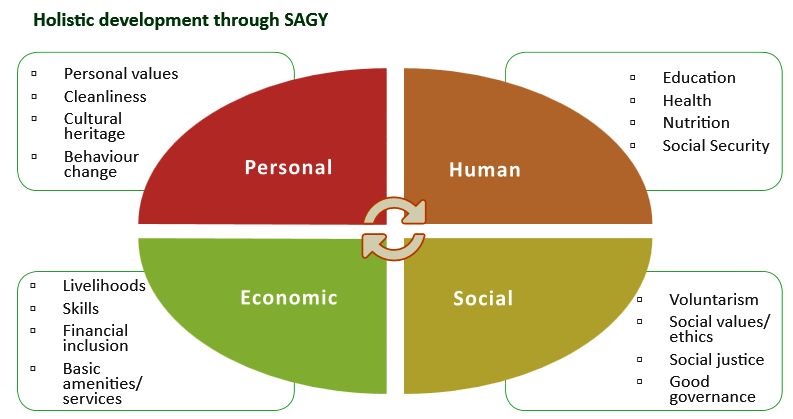Governance
Saansad Adarsh Gram Yojana (SAGY)
- 09 Aug 2021
- 5 min read
Why in News
Recently, the Union Minister of State for Rural Development has informed in Rajya Sabha about the various steps taken by the government for implementation of the Saansad Adarsh Gram Yojana (SAGY).
Key Points
- SAGY:
- About:
- The scheme was launched in 2014 on the birth anniversary of Jai Prakash Narayan.
- Under the Yojana, Members of Parliament (MPs) are responsible for developing the socio-economic and physical infrastructure of three villages each by 2019, and a total of eight villages each by 2024.
- The first Adarsh Gram (Model Village) was to be developed by 2016, and two more by 2019.
- From 2019 to 2024, five more Adarsh Grams must be developed by each MP, one each year.
- The MPs would be free to identify a suitable Gram Panchayat for developing Adarsh Gram, other than his/her own village or that of his/her spouse.
- The Ministry of Rural Development has brought out a compilation of 127 Central Sector and Centrally Sponsored and 1806 State Schemes for convergence under SAGY.
- Process:
- Gram Panchayat (GP): The basic unit for development.
- Lok Sabha MP: Chooses a GP from within his/her constituency.
- Rajya Sabha MP: Chooses a GP from the rural area of a district of his/her choice in the State from which he/she is elected.
- Nominated MP: Chooses a GP from the rural area of any district in the country.
- The MPs engage with the community, facilitate the Village Development Plan and mobilise the necessary resources particularly from Corporate Social Responsibility (CSR) and philanthropies.
- MPs also fill up critical gaps in the plan using the Member of Parliament Local Area Development Scheme (MPLADS) funds.
- About:
- Expected Outcomes:
- Increased livelihoods/employment opportunities.
- Reduction in distress migration.
- Freedom from bonded labour, child labour and manual scavenging.
- 100% registration of deaths and births.
- Evolution of alternate dispute resolution system acceptable to all sections of the community.
- Peace and Harmony.
- Demonstration effect on other Gram Panchayats.
- Issues:
- Low Selection of Panchayats:
- So far, only 2,111 gram panchayats have so far been identified under this programme and of that, 1,618 have prepared their development plans.
- A total of 79,316 activities have been planned for these villages, of which 49,756 have been completed.
- Lack of Interest and Funds:
- In many SAGY villages, the MPs did not give any significant funds from MPLADS.
- Lack of Political Will:
- The concept of SAGY has not percolated down to field officials due to lack of accountability and political will.
- Issues with Declaration:
- Even villages declared as Adarsh Grams in some districts were found yet to be Open Defecation Free.
- Limited Impact:
- In some cases, where MPs have been proactive, some infrastructure development has taken place, but the scheme has not made any perceptible impact.
- Low Convergence of MGNREGA with MPLAD:
- Lesser convergence of Mahatma Gandhi National Rural Employment Guarantee Act (MGNREGA) with MPLAD was observed in few villages.
- Rural Roads:
- Concerns have also been raised over the quality of roads constructed under schemes of state governments and maintenance of rural roads under central Pradhan Mantri Gram Sadak Yojana (PMGSY).
- Low Selection of Panchayats:
Way Forward
- The vision behind the evolution of SAGY villages was to create model villages by ensuring convergence and dovetailing of schemes and its proper implementation on priority basis. However, the seriousness required to achieve the motto is lacking. There is a need for MPs to be more responsible towards the scheme.
- SAGY gives focus to community participation and social mobilization of the village community can trigger a chain of other development activities in the village.





